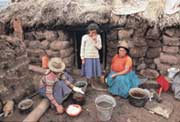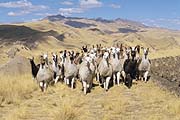
The Land

Potato Harvest, near Cuzco
(c) Jon Spaull/Panos Pictures
|

(c) Jeremy Horner/Panos Pictures |
Peru can be divided into three main areas: the coast, the highlands and the change from mountains to rainforest in the east.
The Pacific coast
The economic power-base of Peru consumes most of the imports and supplies half of the country's exports. With irrigation the valleys are fertile. In the north there are mangrove swamps and tropical rainforest but to the south there is dry barren land and shifting sands. Although rainfall is extremely low over fifty rivers flow from the Andes into the sea.
The Highlands
Called the sierra and with half the population living here, these range from 250 kilometres wide in the north to 400 kilometres wide in the south. The average altitude is 3,000 metres but the area has mountain peaks and deep canyons. The Huascaran peak at 6,768 metres is sometimes given as the second highest point in South America although at least five peaks near the Argentina-Chile border are higher. The snowline varies from 4,500 metres in the north of the country to 6,000 metres in the south. This reverses normal expectation but is the result of the Humboldt ocean current and the effect of high altitude.
Eastern Andes and the Amazon basin
Almost half of Peru is on the eastern side of the Andes and ninety per cent of the drainage feeds into the vast Amazon basin. There is cloudforest above 3,500 metres and tropical rainforest lower down where river water is the only practical means of transport. The mountain area has deep valleys and jagged ridges. The lower land has very little of the grassland found elsewhere in the Amazon and, yet, this is the home for the llama.
Peru has dramatic canyons with spectacular waterfalls. It suffers earthquakes which in turn cause avalanches and landslides. It also has dormant and recently active volcanoes. Lake Titicaca, half of which is in Bolivia, is the largest lake in South America and at 3,812 metres is the highest navigable body of water in the world.




